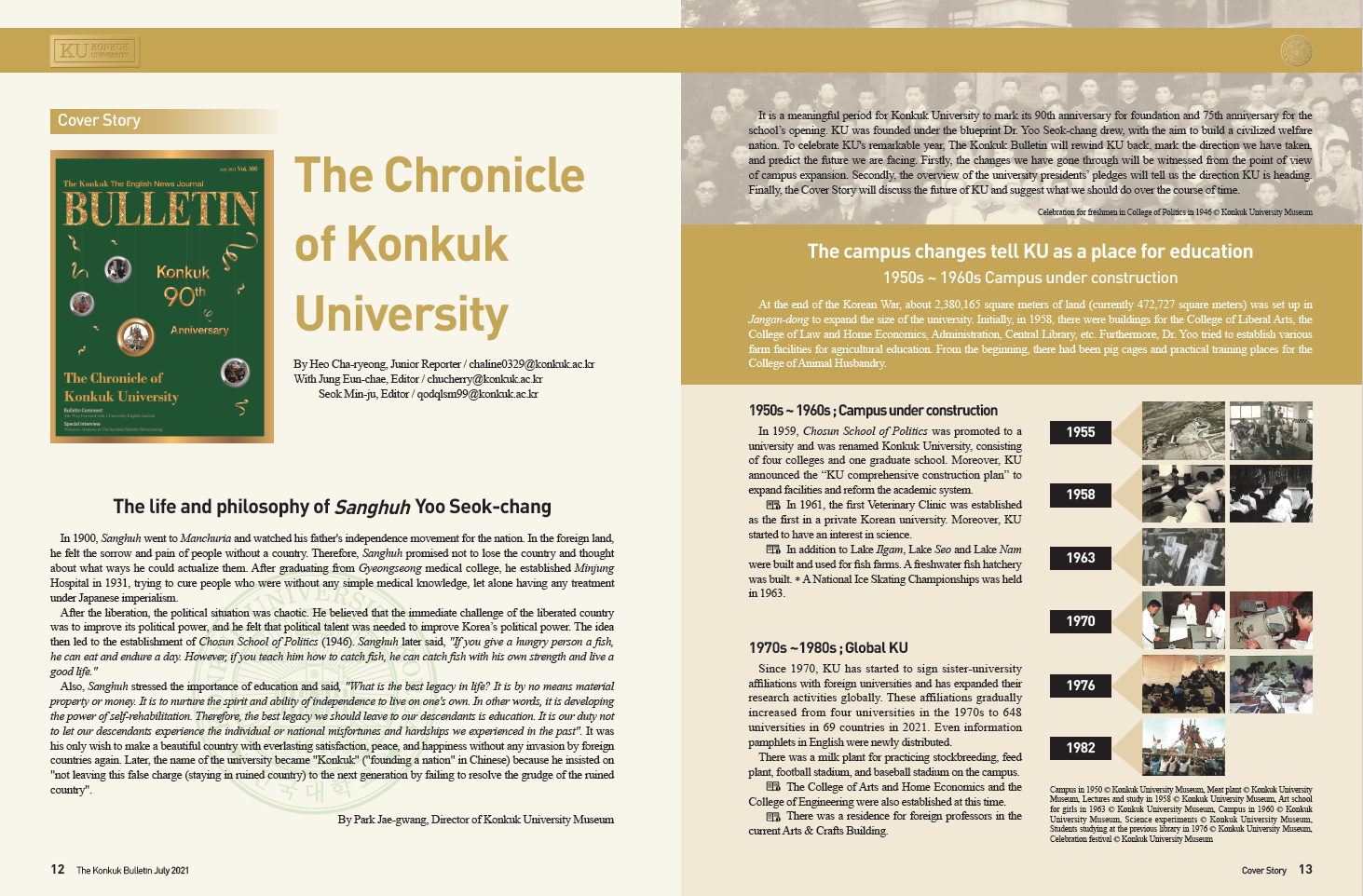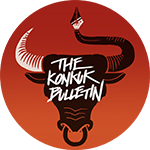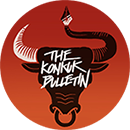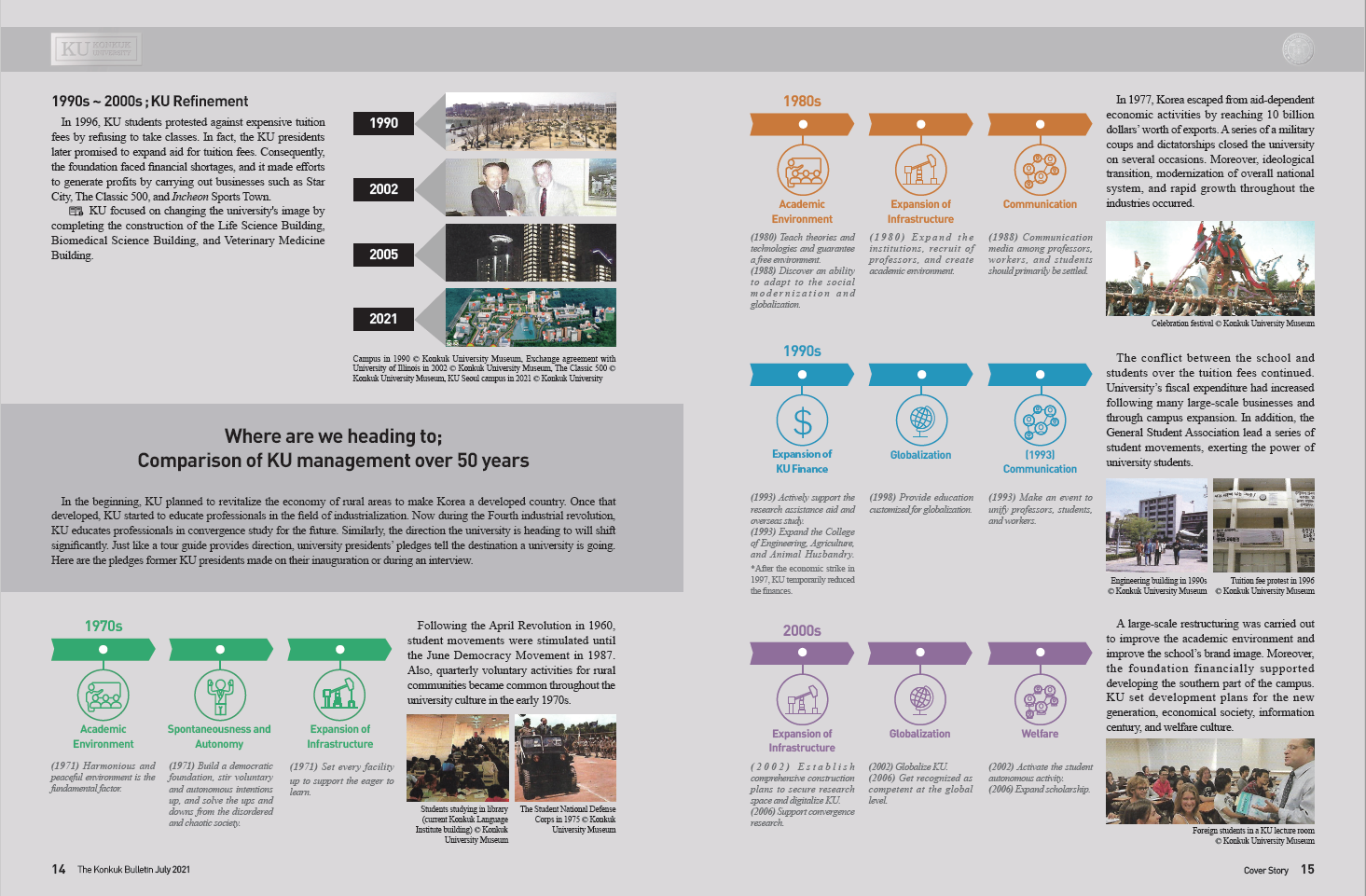
|
The life and philosophy of Sanghuh Yoo Seok-chang
In 1900, Sanghuh went to Manchuria and watched his father's independence movement for the nation. In the foreign land, he felt the sorrow and pain of people without a country. Therefore, Sanghuh promised not to lose the country and thought about what ways he could actualize them. After graduating from Gyeongseong medical college, he established Minjung Hospital in 1931, trying to cure people who were without any simple medical knowledge, let alone having any treatment under Japanese imperialism.
After the liberation, the political situation was chaotic. He believed that the immediate challenge of the liberated country was to improve its political power, and he felt that political talent was needed to improve Korea’s political power. The idea then led to the establishment of Chosun School of Politics (1946). Sanghuh later said, "If you give a hungry person a fish, he can eat and endure a day. However, if you teach him how to catch fish, he can catch fish with his own strength and live a good life."
Also, Sanghuh stressed the importance of education and said, "What is the best legacy in life? It is by no means material property or money. It is to nurture the spirit and ability of independence to live on one's own. In other words, it is developing the power of self-rehabilitation. Therefore, the best legacy we should leave to our descendants is education. It is our duty not to let our descendants experience the individual or national misfortunes and hardships we experienced in the past". It was his only wish to make a beautiful country with everlasting satisfaction, peace, and happiness without any invasion by foreign countries again. Later, the name of the university became "Konkuk" ("founding a nation" in Chinese) because he insisted on "not leaving this false charge (staying in ruined country) to the next generation by failing to resolve the grudge of the ruined country".
By Park Jae-gwang, Director of Konkuk University Museum
It is a meaningful period for Konkuk University to mark its 90th anniversary for foundation and 75th anniversary for the school’s opening. KU was founded under the blueprint Dr. Yoo Seok-chang drew, with the aim to build a civilized welfare nation. To celebrate KU's remarkable year, The Konkuk Bulletin will rewind KU back, mark the direction we have taken, and predict the future we are facing. Firstly, the changes we have gone through will be witnessed from the point of view of campus expansion. Secondly, the overview of the university presidents’ pledges will tell us the direction KU is heading. Finally, the Cover Story will discuss the future of KU and suggest what we should do over the course of time.
The campus changes tell KU as a place for education
1950s ~ 1960s Campus under construction
At the end of the Korean War, about 2,380,165 square meters of land (currently 472,727 square meters) was set up in Jangan-dong to expand the size of the university. Initially, in 1958, there were buildings for the College of Liberal Arts, the College of Law and Home Economics, Administration, Central Library, etc. Furthermore, Dr. Yoo tried to establish various farm facilities for agricultural education. From the beginning, there had been pig cages and practical training places for the College of Animal Husbandry.
1950s ~ 1960s ; Campus under construction
In 1959, Chosun School of Politics was promoted to a university and was renamed Konkuk University, consisting of four colleges and one graduate school. Moreover, KU announced the “KU comprehensive construction plan” to expand facilities and reform the academic system.
In 1961, the first Veterinary Clinic was established as the first in a private Korean university. Moreover, KU started to have an interest in science.
In addition to Lake Ilgam, Lake Seo and Lake Nam were built and used for fish farms.A freshwater fish hatchery was built. * A National Ice Skating Championships was held in 1963.
1970s ~1980s ; Global KU
Since 1970, KU has started to sign sister-university affiliations with foreign universities and has expanded their research activities globally. These affiliations gradually increased from four universities in the 1970s to 648 universities in 69 countries in 2021. Even information pamphlets in English were newly distributed. There was a milk plant for practicing stockbreeding, feed plant, football stadium, and baseball stadium on the campus.
The College of Arts and Home Economics and the College of Engineering were also established at this time.
There was a residence for foreign professors in the current Arts & Crafts Building.
1990s ~ 2000s ; KU Refinement
In 1996, KU students protested against expensive tuition fees by refusing to take classes. In fact, the KU presidents later promised to expand aid for tuition fees. Consequently, the foundation faced financial shortages, and it made efforts to generate profits by carrying out businesses such as Star City, The Classic 500, and Incheon Sports Town.
KU focused on changing the university's image by completing the construction of the Life Science Building, Biomedical Science Building, and Veterinary Medicine Building.
Where are we heading to;
Comparison of KU management over 50 years
In the beginning, KU planned to revitalize the economy of rural areas to make Korea a developed country. Once that developed, KU started to educate professionals in the field of industrialization. Now during the Fourth industrial revolution, KU educates professionals in convergence study for the future. Similarly, the direction the university is heading to will shift significantly. Just like a tour guide provides direction, university presidents’ pledges tell the destination a university is going. Here are the pledges former KU presidents made on their inauguartion or during an interview.
1970s
Following the April Revolution in 1960, student movements were stimulated until the June Democracy Movement in 1987. Also, quarterly voluntary activities for rural communities became common throughout the university culture in the early 1970s.
(1971) Harmonious and peaceful environment is the fundamental factor.
(1971) Build a democratic foundation, stir voluntary and autonomous intentions up, and solve the ups and downs from the disordered and chaotic society.
(1971) Set every facility up to support the eager to learn.
1980s
In 1977, Korea escaped from aid-dependent economic activities by reaching 10 billion
dollars’ worth of exports. A series of a military coups and dictatorships closed the university on several occasions. Moreover, ideological transition, modernization of overall national system, and rapid growth throughout the industries occurred.
(1980) Teach theories and technologies and guarantee a free environment.
(1988) Discover an ability to adapt to the social modernization and globalization.
(1980) Expand the institutions, recruit of professors, and create academic environment.
(1988) media among professors, workers, and students should primarily be settled.
1990s
The conflict between the school and students over the tuition fees continued. University’s fiscal expenditure had increased following many large-scale businesses and through campus expansion. In addition, the General Student Association lead a series of student movements, exerting the power of university students.
(1993) Actively support the research assistance aid and overseas study.
(1993) Expand the College of Engineering, Agriculture, and Animal Husbandry. *After the economic strike in 1997, KU temporarily reduced the finances.
(1998) Provide education customized for globalization.
(1993) Make an event to unify professors, students, and workers.
2000s
A large-scale restructuring was carried out to improve the academic environment and improve the school’s brand image. Moreover, the foundation financially supported developing the southern part of the campus. KU set development plans for the new generation, economical society, information century, and welfare culture.
(2002) Establish comprehensive construction plans to secure research space and digitalize KU.
(2006) Support convergence research.
(2002) Globalize KU.
(2006) Get recognized as competent at the global level.
(2002) Activate the student autonomous activity.
(2006) Expand scholarship.
2010s
Current KU plans to foster global intellectuals who can lead in the new technological economic society. KU established “Renaissance Konkuk 2031” to become a World Top 100 University by 2031.
(2012) Expand non-tuition fee finance, government funding, and income.
(2010) Build eco-friendly smart campus.
(2020) Education infrastructure for the leading technology.
(2012) Enforce global networks, and receiveroriented education for the 21st century global professional education.
(2020) Establish a communication system for university's members.
KU has experienced three major turning points in the last 50 years. From 1970s to 1980s, KU expanded its campus and reinforced the university as an institution amid an unsettled society. From 1990s to 2000s, KU globalized and financially expanded. The financial and facility infrastructure, and systemic restructuration helped the next generation in 2010s to educate smart professionals as future leaders. Overarchingly, one identical identity exists: communication and welfare for the members of the school. It means we have always been a necessary part of the school, and we are the key to change the direction KU is heading to.
Future university and future students
For KU to become a world-leading university, it is important to be aware of what we will face in the future. Knowing the destination buys some time for us to prepare. Yet, it is also important to evaluate what hinders us from reaching the destination.
KU future in trans-generation
OECD says the future generation should first build the core foundation of “Literacy and numeracy”, “Data and digital literacy”, “Physical and mental health”, and “Social and emotional foundations”. Once we build the basis, we should utilize the tools and set the direction to adapt to society. Transformative competencies, which include “creating new values”, “reconciling tensions and differences”, and “taking responsibility” are these tools. All these elements should be taught through anticipation, action, and reflection.
Similarly, KU has presented three educational goals ever since the foundation: sincerity, fidelity, righteousness. KU defines sincerity as “intellectuals with a well-rounded character”, who are “rational, creative, and with good judgement, sincere, positive, and trustworthy”. Meanwhile, fidelity was newly defined as “future-oriented professionals”. KU not only values competence in academic theories but also the applications. In addition, righteousness was defined as contribution to the nation and community with a common good.
The OECD and KU education goals explain a single statement in common; learn and transform knowledge with good character and intention and contribute the knowledge to society. Furthermore, the importance of community development is highly recommended.
The current problem the university faces:
The industrialization of the university
There is a promise that every KU president makes, and that is the expansion of finance. KU is a private school, hence taking a certain amount of profit is inevitable. Then, how do KU and other universities draw finance? It is through Industry-University Collaboration for research. The following are the critical evaluations National Research Foundation of Korea made about Korean universities in general in 2005.
“Currently research is centered on the IT industry.”
“Long-term plans are required. It is necessary to secure original technology for continuous development of the national economy.”
Since this evaluation, the contract period in the software industry has remained the same up until 2019, and most research still centers on the IT industry. Even 14 years after the evaluation, “the university industry” still focuses on drawing money from industry, leaving the studies behind. On top of this, the types of study are not evenly distributed and are centered on IT. These short-term types of contracts are from companies aimed at solving their own problems. This leads to a problem in that the solution is barely returning to society because the solution is just for-profit.
Despite the academic autonomy and independence from 1970s to 1980s, no improvement can be found even if we take advantages of high-technology equipment these days. The current university receives contracts from companies and willingly becomes a part of their industrialization. Universities should stop putting productivity, efficiency, and economic feasibility first, but run research in academically correct ways.
What is a good university, and what is a good student?
Universities surely have been a good driving force in society. After independence, research for agriculture and stockbreeding not only helped the rehabilitation of rural areas but also expanded to help the nation. During the restoration, university students actively and directly participated in social issues through volunteering activities. Moreover, when they were under unreasonable military ruling power, they also actively and directly participated in protests and lead Korea to becoming a complete democracy. Finally, they were there to be of use as a part of production line under industrialization, which developed Korea financially.
Now we confront many problems derived from the 4th industrial revolution. The unemployment rate is rising, energy resources are running out, the environment is being destroyed, and our private lives are exposed. Most importantly, many experts say among those problems, our society will polarize according to people’s level of wealth, the living region, and many other factors.
We need to take responsibility and must come up with solutions, not just pass them on to the next generations just like our seniors took responsibilities during their times. To be a good university, a university developing the community, we and our intentions are the keys; Have good intention. Take responsibility. Act upon them.
Conclusion
As a private school, KU should feel pride for a 90 years-long history. In the early years people could not even learn the Korean language due to the colonization. Since then, KU has started with a single building, Chosun School of Politics. And now the number of colleges has increased from only two to nineteen, and the dream about globalization from 50 years ago has come true. We are preparing for the future as we have always been. Each small step of advancing, staying, and retreating is not immediately recognizable, as the whole mountain cannot come into view at once when we are hiking on it. Compared to KU 50 years ago, and Korea 100 years ago, we inherited a better era. Moreover, as always, our next 50 years will also be further developed. Not only should we celebrate KU’s 90th anniversary itself, but we should also remember KU youth who kept the campus full of vigor, passion, and will. By doing so, we should take responsibility by striving to contribute and become of use for society.
Heo Cha-ryeong,Junior Reporter
chaline0329@konkuk.ac.kr



